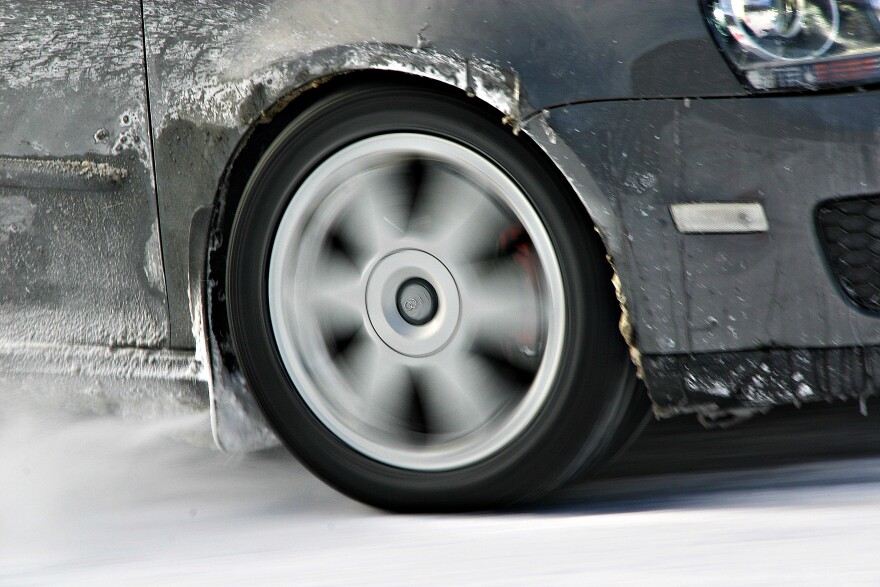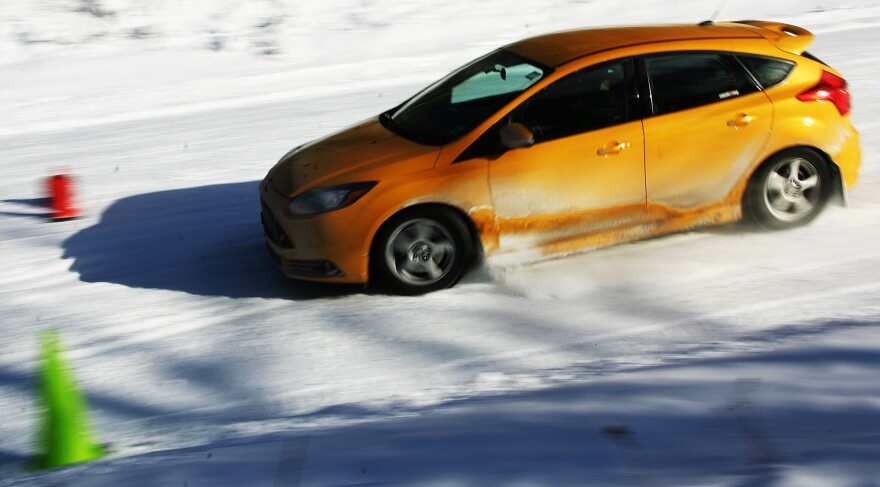Winter has indisputably arrived and most of the state’s drivers figure they know what to do when the roads get slick. But a company in the North Country is helping drivers polish those skills and learn a few things even veterans of the ice capades may not know.
One of those drivers is Judy Gessner, of Whitefield, who is behind the wheel of a Honda Odyssey minivan, and, with increasing confidence she is slaloming between big, orange cones despite a slick, snowy surface.
She’s a retired school teacher and one of just over a dozen students attending the $499, day-long winter driving school at Team O’Neil Rally School & Car Control Center in Dalton.
Gessner has always lived in places where she had to drive in the snow. But she thought there might be room for improvement.
“It just seemed reasonable to pick up whatever professional hints I could about how to do it better,” she says.

Gessner and the other students are using O'Neil's network of private roads and large open areas where students can safely go slip, sliding away.
Most of the time O’Neil’s instructors teach rally driving, the point of which is going very quickly on loose surfaces such as snow or dirt. So, the instructors have lots of expertise in handling skids.
During the day there’s some classroom instruction and lots of driving.
And while it is possible to rent a car, everyone in this class is driving the family vehicle.
They include the Honda minivan, a Volkswagen GTI, Ford Focus and Volvo station wagon.
The students range from Baby Boomers to teens.
They come from New Hampshire, New Jersey, Massachusetts and Canada.
One of the first points made by chief instructor Travis Hanson is that snow tires are important because they have a special rubber compound designed for cold temperatures and special tread patterns. That means they do a much better job helping a vehicle stop and turn as well as get moving.
"I would much prefer a front-wheel drive car or rear-wheel drive car with snow tires over an all-wheel drive car even with an all-season tire."
A major theme is being smooth.
Gentle with the steering.
Easy on the gas and easy on the brakes.
Jerking the car around can result in tires losing an already tenuous grip.
And it is necessary to remember that things that work on dry pavement can be trouble on a slippery surface.
For example on a dry surface a driver can often brake while the car is turning. That’s not a great technique but the tires generally have enough grip to handle both duties.
But in the snow that’s asking for trouble, says Hanson.
“You really want to do one thing at a time. You really shouldn’t be trying to slow and turn at the same time on a slippery surface. You should really try and do it separately. Slow down first for the corner and then make it through the corner.”
Many new cars come standard with electronic stability control. Such systems use sensors and a computer to try and automatically correct for skids. Independent research has shown such systems work and significantly reduce single-vehicle accidents caused by the driver losing control.
But older cars usually lack electronic stability control and safety experts say it is important to know how to minimize the chances of getting into a skid as well as being able to handle one without electronic assistance.
Handling skids is largely accomplished through weight transfer. By that Hanson means shifting the vehicle’s weight between the front and rear tires depending on where more grip is needed.
Weight can be shifted to the front tires by braking or lifting off the gas.
Weight can be shifted to the rear tires by accelerating.
It doesn’t matter much if the vehicle has front-wheel drive, rear-wheel drive or all-wheel drive.
How that weight transfer is used depends on the type of skid.
One type of skid is called understeer. That’s when a vehicle doesn’t want to go through a turn.
“You add steering input whether it is right or left and the car generally goes straight. It understeers,” he says.
The problem is that front tires don’t have enough grip.
So, the driver should lift off the gas or possibly apply a very light touch of brakes to put more weight up front and increase the grip, says Hanson.
If the front wheels are turned sharply - so the tires are little bit sideways - the tread may have a hard time getting grip. It can help to straighten the front wheels slightly.
Oversteer involves the other end of the vehicle. The tail is sliding around.
How the driver should handle oversteer depends on what caused it.
One mistake could be lifting off the gas in the middle of a turn. That can transfer weight off the rear tires to the fronts. And, reducing the grip of the rear tires can cause them to slide, Hanson says.
“Well, in that case you might actually have to get back on the gas to transfer weight to the rear two tires to regain grip."
On a rear-wheel drive car oversteer could also be caused by too much accelerating.
“Then, you might need to lift back off the gas,” he says.
Handling oversteer also requires some work with the steering wheel.
If the rear of the vehicle is sliding to the right, then the steering wheel should be turned to the right.
If the rear of the vehicle is sliding to the left, then the steering wheel should be turned to the left.
And whether the skid involves understeer or oversteer the driver should look where he wants to vehicle to go, says Hanson.
“Looking where you want to go is one of the most important things I think a driver can do when things go wrong."
Staring at something the driver is worried about hitting – like a tree – is a problem because there is an involuntary tendency to aim the vehicle where the driver is looking.
“In general, if you are looking where you want to go you are going to do the right things with your hands and your feet,” Hanson says.
One of the most important exercises of the day is a slalom between big, orange highway cones.
It is a chance to practice correcting for understeer heading into the turn and then oversteer coming out.
The strategy of weight transfer.
And that’s something very new to Judy Gessner, the Whitefield resident who’s driven in snow all her life.
“I’m learning how to shift the weight with the car so I have more advantage with the tires. And, I never thought much about that before. How much gas, how much brake, how much steering and trying to balance those. Where I might have thought of only one, now I am thinking of all three.”
Additional classes are scheduled in January, February and March.
For diagrams on the different types of skids and how to handle them as well as other winter-driving tips go here.








